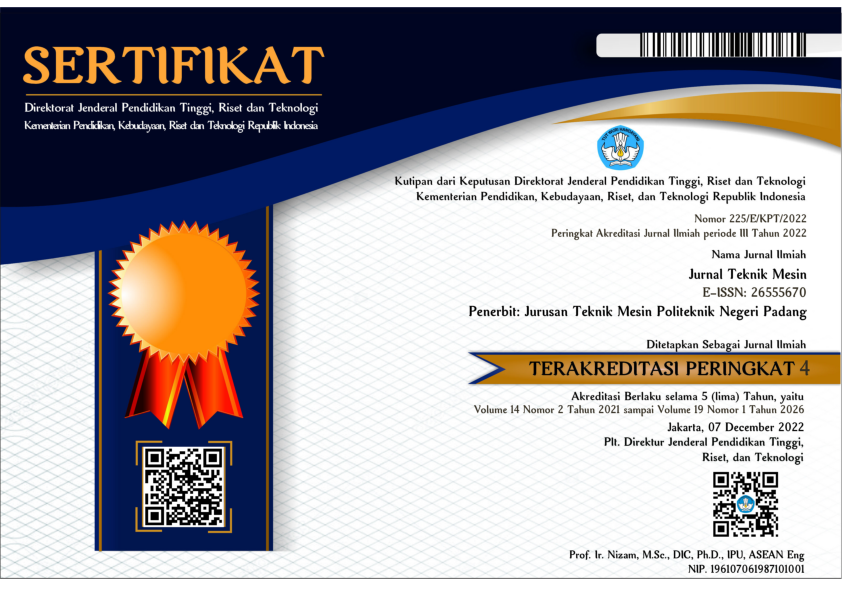Pengaruh Perbedaan Ukuran Intake Kontraksi Terhadap Laju Aliran Di Ruang Uji
Abstract
The contraction cone or intake is a very important part of wind tunnel design because it has a high impact on the quality of airflow in the test section. The design of the contraction cone aims to create the air pressure required at the time of entry of the test section without experiencing much turbulence. This research was conducted using an experimental method, where in this study it was carried out by testing, making 3 intake components or funnels of different sizes. The calculation results obtained funnel 1 contraction with a value of 11,466 m3 / s, funnel 2 contraction with a value of 12,266 m3 / s, and funnel 3 contraction with a value of 12,533 m3 / s. These results show that the size of the contraction affects the wind flow rate inside the test chamber. Where changes in the size of contractions will increase the wind flow rate, which is caused by the increasing size of the contraction cross-sectional area so that the shelter area or wind flow area that will move towards the test room increases in size or area
References
Agni, M., Kirom, M.R. and Bethaningtyas, H., 2015. Analisis Kinerja Terowongan Angin Subsonik Dengan Menggunakan Contraction Cone Polinomial Orde 5. eProceedings of Engineering, 2(3).
Risnawan, N., Yohanes, F.A., Sunarno, S., Novianti, H. and Feriadi, Y., 2019. Pengukuran Kualitas Kecepatan Angin pada Terowongan Angin di ILST BBTA3. Journal of Aero Technology, 2(1).
Siregar, A.M., 2016. Rancang bangun wind tunnel sederhana untuk alat pendukung studi eksperimental. Mekanik: Jurnal Ilmiah Teknik Mesin, 2(2).
Setyawan, D. L., Mulyadi, S., Sholahudin, I., Rosyadi, A. A., & Asrofi, M. 2022. analisis pengaruh jumlah sudu terhadap unjuk kerja blower sentrifugal type back ward dengan honeycomb dan tanpa honeycom. STATOR: Jurnal Ilmiah Teknik Mesin, 5(2), 57-60.
Yuniarsih, N. and Rossbandrio, W., 2015. Pengembangan Terowongan Angin Kecepatan Rendah (Low Speed Wind Tunnel) Untuk Tujuan Edukatif di Politeknik Negeri Batam. Jurnal Integrasi, 7(1), pp.19-22.
Agni, M., Kirom, M. R., & Bethaningtyas, H. 2015. Analisis Kinerja Terowongan Angin Subsonik Dengan Menggunakan Contraction Cone Polinomial Orde 5. eProceedings of Engineering, 2(3).
Fakhruhrozi, A.J. and Mulyadi, M., 2021. Airflow Pattern Simulation in Open Type Wind Tunnel with Test Section 40 cm X 40 cm X 80 cm. Indonesian Journal of Innovation Studies, 13, pp.10-21070.
Jihad, B.H. and Priadi, D., 2011. Desain Alat Uji Nosel Dengan Menggunakan Prinsip Terowongan Angin Supersonik. Jurnal Teknologi Dirgantara, 9(1).
Idris, I.M., 2019. Rancang Bangun Terowongan Angin (Wind Tunnel) Tipe Subsonic Dengan Test Section 0, 2 X 0, 2 M Untuk Alat Peraga Mekanika Fluida. Mechonversio: Mechanical Engineering Journal, 2(2), pp.19-24.
Hidayat, M.F. and Xaverius, F., 2022. Rancang Bangun Terowongan Angin Kecepatan Rendah Tipe Terbuka Sederhana dengan Smoke Generator Sebagai Visualisasi Aliran Udara Untuk Alat Pratikum. Jurnal Kajian Teknik Mesin, 7(2), pp.63-72.













